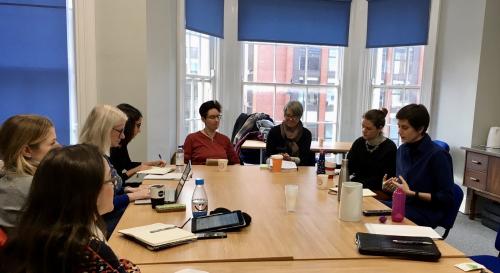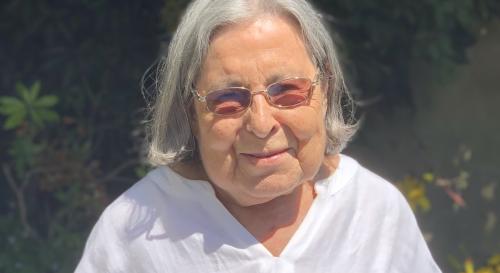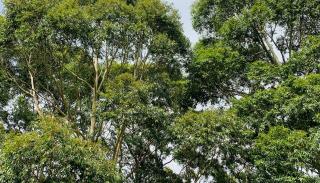
Breadcrumbs navigation
The global tree: Forests and the possibility of a multispecies IR
Stefanie R Fishel discusses the key arguments from her Review of International Studies (RIS) article. If you'd like to know more you can read the full article - The global tree: Forests and the possibility of a multispecies IR
On a warm winter’s day, I helped plant 75 trees near Noosa, Queensland on the east coast of Australia. The non-profit I am a part of organised the planting on a beautiful property with owners who are regenerating their land for local wildlife, as they build an eco-retreat on an old macadamia farm. We planted native trees in the hope that koalas and other native critters could have a safe place to return after worsening habitat fragmentation by property development and highway upgrades in the region.
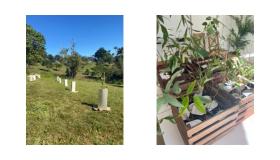
One of these trees was the Eucalyptus propinqua, or the ‘Small Fruited Grey Gum’. It is a medium to tall tree endemic to coastal eastern Australia. Its new bark is bright orange-yellow and has nectar and pollen producing flowers that bloom in the summer. It is clay tolerant and drought hardy. The grey gum attracts bees; they feed gliders, flying foxes, and koalas.
If koalas are icons of Australian fauna, gum trees, or eucalypts, are the flora equivalent. There are more than 800 species dominating the landscape with gums forming forests, woodlands, and shrublands. According to the Australian Academy of Science, DNA sequencing and fossil discovery indicate that eucalypts evolved in Gondwana and that modern eucalypts are very similar to the ancient trees from which they are descended. Eucalypts are evergreens well suited to live in harsh environments: their leathery leaves maximize light and water absorption and they quickly re-sprout following damage from drought or fire.
Also, much like the koala, their iconic status has not kept many of the species from coming under threat. In Queensland they are not protected even though the state has one of the highest deforestation rates in the world. New South Wales (NSW) is almost as large a culprit, but there the Grey Box-Grey Gum is listed as endangered as part of an ecological community in the NSW North Coast Forest Bioregion. All told, in a report from the World Wildlife Fund, eastern Australia remains one of the top 24 global deforestation fronts. As reported on their website, ‘Land clearing rates rocketed after the axing of restrictions in Queensland and NSW placing eastern Australia alongside the most infamous places in the world for forest destruction,’ said WWF-Australia conservation scientist Dr Martin Taylor.
The story of eucalyptus propinqua illustrates many of the issues that haunt our forests globally. I sought to capture this complexity in my article ‘The global tree: forests and the possibility of a multispecies IR’ from an international perspective, but soon realized that forest governance cannot be separated from each tree on the planet: every tree is simultaneously a global tree. I begin from the fact that forest ecosystems are vital to life on the planet and then examine the forest from an international and postcolonial viewpoint. The destruction (and protection) of many forests globally is invariably located in post- and endo-colonial settings.
As with so many other global issues, the international community, following the lead from Indigenous people and local communities, must work to untangle and remove alien legal and political systems imported during colonial rule, as well as reckon with the continuing legacies of extractive and violent relationships with biodiversity and more-than-human biological communities. Reducing deforestation will require efforts at all levels by engaging local communities and Indigenous peoples, women and youth, and civil society and the private sector. These should happen through a transparent framework that builds trust.
The difficulty in assessing forest ecosystem services for a more overarching forest treaty is a complex task that relies on loaded assumptions and pricing of natural systems. Forest ecosystems also vary on a global scale, from tropical to boreal forests, from plantations to parks. From a resource standpoint, there are five thousand different commercial wood products and non-wood forest products like mushrooms, maple syrup, rubber, and oil and resins that play a crucial role in many economies. These lead to multiple competing interests around forests, their protection, and their uses for human consumption. A tree centred approach only adds to the complexity: How could the intrinsic value of a tree reflected in a purely economic response?
It is the forest in its own context that we must turn to now. In previous work I have played with the power of metaphor to theorize IR and its relationship to the material world; in this article I add the cultural, symbolic and life of the tree in the forest to speak to IR. Trees, and their forest ecosystems, play keystone roles in planetary climate health and, through their interconnections between and among species, can serve as guides for healthier human communities. They are thus crucial to the survival of life on planet Earth and must be understood as a major site of crisis and possibility as we push deeper into the Anthropocene. Trees flourish in symbiotic communities that extend from the smallest ecosystems to the biosphere itself, provide homes for millions of species, change the composition of the atmosphere, and mitigate global heating and climatic change.
Trees also have deep meanings for human societies. Wangari Maathai’s Green Belt Movement (GBM) in Kenya demonstrates the connections between environmental justice, social justice, the tree, and the forest. The GBM was founded in 1977 in response to rural women’s struggles with environmental degradation. Water and food supplies were disappearing and becoming less secure, and they had to travel much farther for fuel and fencing. The organisation encouraged women to work together to plant trees to help with soil degradation and store rainwater and wood for various needs. Maathai and her organisation have planted more than 51 million trees with four thousand community nursery groups.
In Slow Violence and the Environmentalism of the Poor, Nixon writes that tree planting in Kenya through the Green Belt Movement and the ‘theatre of the tree’ was a practical response to environmental calamity, but that it was also a way to ‘metaphorically cultivate democratic change ... the gesture could bring new life into a dead metaphor of grassroots democracy’. It cultivates a powerful intersectional environmentalism that frees the tree planter from top down, hierarchical cultures. It regenerates both forests and civic life and is ‘a radically subversive bottom-up ethic with a long timeline of tree growth’.
So let us consider the embedded and material global forest as a fruitful thought experiment: an alternative more-than-human ‘tiers monde’ of the twenty-first century. Trees and their needs do not replace the very important ongoing debate about humans and global environmental justice and resource control, but rather add to the imperative to take a holistic view of justice for the human and more-than-human alike. Many ongoing global inequities are about such issues.
Humanity’s rapid deforestation of the earth demonstrates the need for a new paradigm given that our destructive interventions are reflected in the entire earth system. Not only are we suffering through a global public health crisis that has its roots in overdevelopment and habitat destruction, we have also exceeded at least four of the nine planetary boundaries as defined in 2009 by Johan Rockström and 28 other renowned scientists. Biosphere integrity and biogeochemical flows (where forest integrity is a fundamental anchor) are beyond the zone of uncertainty, and land-system and climate change are in a zone of increasing risk. The planet is currently undergoing a sixth great extinction event due to human activity. These presage irreversible Earth system tipping points that could be similar in scale and severity to the world wars of the twentieth century.
This surely is the terrain of IR, a discipline that has always wrestled with large-scale change and crisis: war, the regulation of chemical and nuclear material and weapons, genocide, and crimes against humanity. In the context of the Anthropocene, deforestation, ocean acidification, land degradation, habitat fragmentation, ice shelf collapse, and climate change bring with them disruptions to human and more-than-human life that have few analogues in human history.
What, then, can the forest and tree teach us about reflexivity and boundaries? A crucial lesson to learn is that healthy ecosystems keep elements within that ecosystem in check to ensure continuing health and resilience for all. Rather than a simple story about survival of the fittest, forests weave an intricate account of solidarity, interdependence, and symbiosis. Trees enjoy systems of ‘social security’ that protect individual trees, the forest, entire ecosystems, the biosphere, and planet Earth. The singular tree is simultaneously the global tree. Different species often struggle for resources, but it is not in the forest’s best interest to lose weaker members.
The tree helped me paint a picture of forested future. As I finish this blog, I sit next to my propinqua sapling. It reminds me that protecting and planting trees is an undertaking filled with hope, and a crucial act of resistance and love.
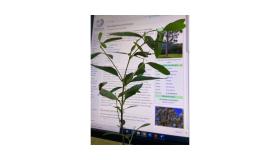
Trees are the lungs of the planet, and, to gently anthropomorphise, have capacious hearts. They care for their young and many other species in the forest. The tree and their forests challenge us to imagine a world that includes the more-than-human, politically and ethically.
In this spirit, I would add ‘Sylvanocene’ to a future list of epochs. Perhaps it could herald a hopeful turn in humanity’s future: the Sylvanocene named as a time to come where forests are globally protected, understood, and valued as support for a thriving and healthy human species and millions of others in the canopy and understory.
An important takeaway for our discipline is to communicate to students, policymakers, politicians, and each other how human societies are entangled with the life and health of the planet. If the forests die, humanity will also suffer and die. Their protection, through concerted efforts for a binding international deforestation treaty and support for local and Indigenous groups protecting trees and forests at the national and subnational level, is vital for global politics and global thriving. These actions can offer a way to create a discipline and a global politics that can move beyond the debates of the last century and find relevance in this one.
Such a project rests on understanding that the human search for justice and survival rests on the survival of forests; that every tree is a global tree. The global forest is not hierarchical and competitive, but flourishes across glorious, heterogeneous, more-than-human communities. Our hierarchies are subsumed into diffuse multispecies relationships across all scales, from the soils to the atmosphere.
Want to know more? You can read Stefanie's full article at DOI: https://doi.org/10.1017/S0260210522000286
This particular article is open access, however BISA members receive access to RIS (and to our other journal European Journal of International Security) as a benefit of membership. To gain access, log in to your BISA account and scroll down to the 'Membership benefits' section. If you're not yet a member join today.
Photo by Sophia Chenery on Unsplash
